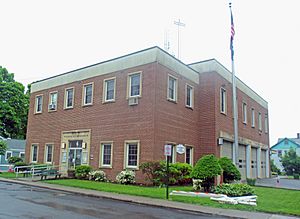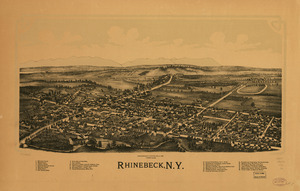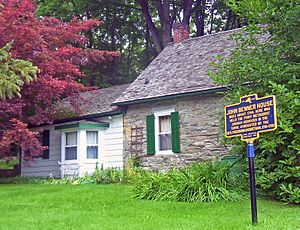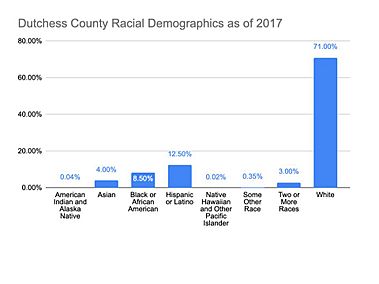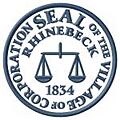Rhinebeck (village), New York facts for kids
Quick facts for kids
Rhinebeck, New York
|
||
|---|---|---|
|
Village
|
||
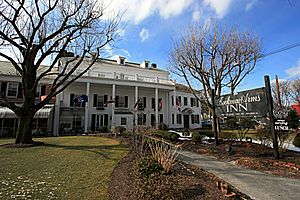
Beekman Arms Inn, the oldest continually operating inn in America.
|
||
|
||
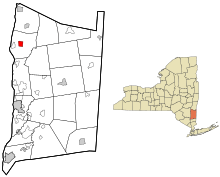
Location of Rhinebeck, New York
|
||
| Country | United States | |
| State | New York | |
| County | Dutchess | |
| Town | Rhinebeck | |
| Incorporated | 1834 | |
| Government | ||
| • Type | Board of Trustees | |
| Area | ||
| • Total | 1.53 sq mi (3.95 km2) | |
| • Land | 1.51 sq mi (3.90 km2) | |
| • Water | 0.02 sq mi (0.05 km2) | |
| Elevation | 200 ft (61 m) | |
| Population
(2020)
|
||
| • Total | 2,697 | |
| • Density | 1,790.84/sq mi (691.52/km2) | |
| Time zone | UTC-5 (Eastern (EST)) | |
| • Summer (DST) | UTC-4 (EDT) | |
| ZIP Code |
12572
|
|
| Area code(s) | 845 | |
| FIPS code | 36-61346 | |
| GNIS feature ID | 0962436 | |
Rhinebeck is a charming village located in Dutchess County, New York. It is part of the larger Town of Rhinebeck. In 2020, about 2,697 people lived here.
Rhinebeck is also part of a bigger area that includes cities like Poughkeepsie and Newburgh. This area is connected to the even larger New York metropolitan region. You can easily reach Rhinebeck using U.S. Route 9, a major road that goes right through the village.
Contents
A Look Back: Rhinebeck's History
Early Native American Life in Rhinebeck
Long before European settlers arrived, the Sepasco band of Native Americans lived in the Rhinebeck area. The name "Sepasco" comes from their word for "little river" or "stream." This likely referred to the Landman's Kill stream, which flows into the Hudson River near present-day Rhinebeck.
The Sepasco people had a well-used trail. It stretched from what is now White School House Road to the Rock City Community. This trail had a special stopping point at a spring. From there, it followed the Landman's Kill stream to a native village near Lake Sepasco.
Colonial Times: European Settlers Arrive
European settlement in Rhinebeck began in 1686. A group of Dutch settlers crossed the Hudson River from Kingston. They bought about 2,200 acres of land from three Sepasco tribe members. Later, Henry Beekman became the owner of this land. He saw the need for a new community.
Beekman brought Casper Landsman, a miller, and William Traphagen, a builder, to the area. In 1703, the New York government approved building the King's Highway. This road is now known as Route 9. Three years later, Traphagen bought land where the King's Highway met the Sepasco Indian Trail. He built a house and a tavern there. This was the very beginning of Rhinebeck.
In 1715, Henry Beekman's son invited 35 German Palatines to settle in the village. These Germans had fled religious problems in their home country. With these new arrivals, Rhinebeck began to grow. New businesses started, and in 1733, the first Reformed Dutch Church was built. The famous Beekman Arms Inn, which is still open today, started operating as a hotel in 1766.
Rhinebeck During the American Revolution
In the 1770s, a former soldier named Richard Montgomery moved to Rhinebeck. He had just married into the important Livingston family. Montgomery was starting a new life as a farmer when the American Revolution began. He was elected to the New York Provincial Congress. Then, he became a general in the Continental Army. Sadly, he died in 1775 during the Battle of Quebec.
Montgomery's original cottage is still standing today. It was moved to 77 Livingston Street. Now, it is home to the local Daughters of the American Revolution chapter. The street where it sits was named in his honor.
Growth and Development After Independence
After America gained independence from Britain, Rhinebeck continued to grow. The larger Town of Rhinebeck was officially formed in 1788. The current Dutch Reformed Church building was completed in 1802. It is the oldest church building in the village.
Many important people visited Rhinebeck. George Washington came in 1796. He dined at a local tavern while staying nearby. In 1804, both Aaron Burr and Morgan Lewis used Rhinebeck taverns as their campaign offices during the governor's election.
The village of Rhinebeck was officially incorporated in 1834. Ten years later, a famous architect named Alexander Jackson Davis built the Henry Delamater House. This house is a great example of the early Gothic Revival style in America.
By the 1850s, Rhinebeck was known for its woodworking. Furniture made here was shipped far away. The village also became famous for making carriages and sleighs. Wealthy families of the Gilded Age started building country estates in the area. They often visited Rhinebeck during the summer and on weekends.
In 1885, Levi P. Morton, a former congressman and ambassador, moved to Rhinebeck. He later became the 22nd Vice President of the United States under Benjamin Harrison. Harrison was visiting Morton in Rhinebeck when they learned they had won the election. Morton also served as governor of New York. He passed away in Rhinebeck in 1920 and is buried in the local cemetery.
The late 1800s brought a new industry to Rhinebeck: growing violets. About 20% of the village's population worked in this business. The total value of the violet crop was sometimes over a million dollars a year! Some of the "violet houses" from this time are still standing.
A map from 1890 shows that the village looked much like it does today. Another important president, Franklin D. Roosevelt, who was from nearby Hyde Park, also played a role in Rhinebeck's history. During the Great Depression, he helped design the new post office. He wanted it to look like Henry Beekman's old house, which had burned down. He even used some of the original stones for the new building. Roosevelt spoke at the dedication ceremony and helped lay the cornerstone. The oldest building in the village is the Benner House, built in 1739.
The Wilderstein mansion, a historic site on the Hudson River, has a long history. It was named "Wilderstein" by Thomas Suckley and his wife Catherine Murray Bowne. The name means "wild man's stone" and refers to an ancient rock carving on the property. This carving was made by the local Sepasco or Esopus people, reminding us of the area's history before Europeans arrived.
Rhinebeck's Location and Surroundings
The U.S. Census Bureau reports that Rhinebeck village covers about 1.53 square miles (3.95 square kilometers). A small part of this area, about 0.02 square miles (0.05 square kilometers), is water.
Rhinebeck is conveniently located:
- It's about 17 miles south of Poughkeepsie, which is the county seat.
- It's about 5 miles north of Red Hook.
- It's about 26 miles north of Hudson.
- Rhinecliff, which has an Amtrak train station, is only 2 miles to the west, right on the Hudson River.
Who Lives in Rhinebeck: Population Facts
Rhinebeck has seen its population change over the years. Here's a quick look at how many people have lived in the village:
| Historical population | |||
|---|---|---|---|
| Census | Pop. | %± | |
| 1820 | 2,729 | — | |
| 1830 | 2,938 | 7.7% | |
| 1840 | 2,659 | −9.5% | |
| 1850 | 2,816 | 5.9% | |
| 1860 | 3,289 | 16.8% | |
| 1870 | 1,322 | −59.8% | |
| 1880 | 1,569 | 18.7% | |
| 1890 | 1,649 | 5.1% | |
| 1900 | 1,494 | −9.4% | |
| 1910 | 1,548 | 3.6% | |
| 1920 | 1,397 | −9.8% | |
| 1930 | 1,569 | 12.3% | |
| 1940 | 1,697 | 8.2% | |
| 1950 | 1,923 | 13.3% | |
| 1960 | 2,093 | 8.8% | |
| 1970 | 2,336 | 11.6% | |
| 1980 | 2,542 | 8.8% | |
| 1990 | 2,725 | 7.2% | |
| 2000 | 3,077 | 12.9% | |
| 2010 | 2,657 | −13.6% | |
| 2020 | 2,697 | 1.5% | |
| U.S. Decennial Census | |||
According to the 2000 census, there were 3,077 people living in the village. About 19.7% of households had children under 18. The average household had 2 people, and the average family had almost 3 people.
The population was spread out in terms of age:
- 18.9% were under 18 years old.
- About 28.7% were 65 years or older.
- The average age was 47 years.
The median income for a household in the village was $41,639. This means half of the households earned more than this, and half earned less. About 9.2% of the total population lived below the poverty line.
Understanding Racial Demographics in Dutchess County
In 2017, the people living in Dutchess County, where Rhinebeck is located, were from many different backgrounds:
- White: 71%
- Hispanic or Latino: 12.5%
- Black or African American: 8.5%
- Asian: 4%
- Two or more races: 3%
- American Indian and Alaska Native: 0.04%
- Native Hawaiian and other Pacific Islander: 0.016%
- Some other race: 0.35%
Education in Rhinebeck
Students in Rhinebeck attend schools within the Rhinebeck Central School District.
Famous People from Rhinebeck
Many interesting people have lived in or been connected to Rhinebeck:
- John Alvin: A talented artist who created movie posters.
- John Jacob Astor IV: A very wealthy businessman who sadly died on the Titanic.
- Vincent Astor: Another wealthy businessman and a generous giver to good causes.
- Joan Juliet Buck: A writer and editor known for her style.
- Antonio Delgado: New York's current lieutenant governor and a former U.S. Congressman.
- Lacey Schwartz Delgado: A filmmaker and the wife of the lieutenant governor.
- Todd Dezago: A comic book writer, co-creator of The Perhapanauts.
- James Gurney: A painter and the creator of the Dinotopia book series.
- Grayson Hall: A well-known film and television actress.
- Joseph Mazzello: An actor.
- Levi P. Morton: The 22nd Vice President of the United States, who lived and is buried in Rhinebeck.
- Richard Nelson: A playwright and writer for operas.
- John A. Quitman: A former governor and congressman from Mississippi.
- Jacob Radcliff: A former mayor of New York City.
- Emma Roberts: A popular American actress.
- Paul Rudd: A famous actor.
- Oliver Sacks: A neurologist and author.
- Ramona Singer: A television personality from The Real Housewives of New York City.
- Margaret Suckley: A cousin of President Franklin Delano Roosevelt.
- Rufus Wainwright: A Canadian-American singer-songwriter.
Images for kids
See also
 In Spanish: Rhinebeck (condado de Dutchess, Nueva York) para niños
In Spanish: Rhinebeck (condado de Dutchess, Nueva York) para niños



